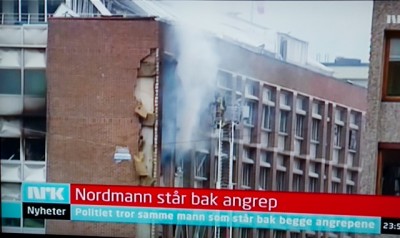The anonymous blogger “Fjordman,” who is repeatedly referenced in the manifesto of Oslo and Utøya terrorist attacks suspect Anders Behring Breivik, was being questioned by Norwegian police on Thursday afternoon after authorities found out his real identity. The international links between Breivik and other far right groups have also continued to be revealed, as well as the suspect’s financial details and a number of other new facts about the case.

The police had been looking for the man behind “Fjordman” for some time, and were eventually able to ascertain his identity on Wednesday. Police reported that they had received “decent” answers during the interrogations but would not go into further detail. Spokesperson Pål-Fredrik Hjort Kraby told Norwegian Broadcasting (NRK) that “Fjordman” was seen as an “especially central” witness for the case given the influence he appears to have had on the suspect.
“Fjordman” had finished his own blog in 2005 but made a public statement on the Gates of Vienna website after the Oslo and Utøya attacks to reject claims that he was Breivik. The blogger said that he “extremely disliked” being mentioned in Breivik’s writings, claiming that he has “never” met the terror suspect. He had continued to contribute to such foreign far right websites after ending his own blog.
Russian links and ‘travelling’ disclosed
The police investigation into the attacks is now over 100 officers strong, and working on 22 separate areas of inquiry. Police from other countries are also helping the part of the investigation looking at online far right activity that might be connected to Breivik. Broadcaster TV2 has reported that it has emerged that Breivik had met Russian neo-Nazi Vjatjeslav Datsik in Oslo, who was previously rejected when he attempted to apply for asylum in Norway after running away from a Russian psychiatric institute. Datsik was jailed in Norway and eventually deported for various offences. Breivik has reportedly had close links with Datsik’s organization, Slavic Union, who were found to possess knives, guns and firebombs when police raided an Oslo tattoo enterprise operated by the group. Breivik is believed to have bought much of his equipment from Russia.
Breivik was interviewed for a further 10 hours on Wednesday in two sessions, with the first being used to go through his statements from an earlier round of questioning and to get his signature. His lawyer, Geir Lippestad, described the tone of the hearings as “professional” but also, as promised by police, “more confrontational.” Lippestad told NRK that Breivik had discussed his “travelling activities” in Norway and “very many countries” in “large parts of Europe,” during which time he had taken “around 20” trips. The suspect had apparently received help in getting hold of equipment from a number of individuals, but would not reveal whom. His lawyer confirmed that “nearly all” of his equipment came from overseas. Meanwhile, his “unrealistic demands” in order to give information about further terror cells in Norway – including that he placed at the top of a new societal order – remained. Furthermore, Lippestad described his client’s experience of solitary isolation as “difficult” but Breivik remains “curious about how Norway and Europe, and with them the rest of the world, have reacted.” He has also described an escape plan he had to get away from Utøya island, which Lippestad describes as “so unrealistic that it is difficult to say anything about it.” Police have also not ruled out that Breivik’s manifesto contains coded messages.
Money in Antigua
In other new details, Breivik has, according to newspaper Dagens Næringslive, told police that he used NOK 6 million (USD 1.1 million) for his terrorist plot. Police are now looking for his money in tax havens, including the Caribbean island of Antigua that is named in his online manifesto, after Breivik was found to have declared a taxable income of just NOK 5,223 (USD 960) in 2007.
Scotland, eastern European countries and other Caribbean states are also under investigation. Norway signed an agreement with Antigua in January this year on sharing information and the country’s authorities have apparently already been contacted by Norwegian police.

Phonecall content and new details revealed
Further details of Breivik’s arrest and subsequent interviews have also been revealed. Newspaper VG reported that the telephone call Breivik made to the police from Utøya said, “Breivik. Commander. Organized in the anti-communist resistance movement against Islamization. The operation is completed and I will give myself over to Delta [the Norwegian police force’s response unit].” Helge Lurås, a terror expert at the Norwegian Institute of International Affairs, told newspaper Aftenposten that the call was either “a game where he came forward with planned initiatives in order to create an aura and mystique around himself,” or that “he fancied himself that he operated on behalf of something bigger.”
Meanwhile, doctors who have worked with victims of the Utøya shootings have told VG that they do not believe that Breivik used poisoned bullets as alluded to in his manifesto, but confirmed that they had seen evidence of what appeared to be expanding bullets, which are banned under many international treaties. Two types of bullets have reportedly been found on Utøya.
Police are considering doing a reconstruction of the Utøya attack, which is considered a normal part of such investigations. The suspect and their legal representative is often allowed to be involved in such a reconstruction, but police spokesperson Christian Hatlo told VG that he doubts such an arrangement will take place in this case.
In terms of the Oslo bombing, it has been revealed by newspaper Adresseavisen that security guards became suspicious of Breivik’s bomb-containing vehicle when he left it outside the government quarter in central Oslo. Guards were about to investigate the car more closely when the bomb went off because they had seen Breivik leave the car in police uniform, which was considered strange.
Views and News from Norway/Aled-Dilwyn Fisher
Join our Readers’ Forum or comment below.
To support our news service, please click the “Donate” button now.

